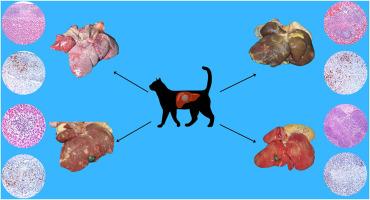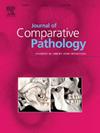Anatomopathological characterization of hepatic lesions of feline infectious peritonitis in cats
IF 0.8
4区 农林科学
Q4 PATHOLOGY
引用次数: 0
Abstract
Feline infectious peritonitis (FIP) is one of the most important infectious diseases and a significant cause of death in cats. While the pathology of FIP has been well documented, there is little information on the hepatic lesions. The aim of this study was to characterize the macroscopic, microscopic and immunohistochemical patterns of the liver lesions in cats with FIP. A retrospective study was conducted on 131 cats with FIP, of which 59 had histological inflammatory lesions in the liver and were immunopositive for feline coronavirus. Four major gross patterns were defined: perihepatitis (21/59); nodular with perihepatitis (18/59); nodular multifocal (13/59); and diffuse (7/59). Four histological patterns were observed: (1) random pyogranulomas; (2) random multifocal to coalescent caseous necrosis surrounded by pyogranulomatous inflammatory infiltrate, fibrin and cellular debris; (3) perihepatitis; and (4) random multifocal to coalescent caseous necrosis surrounded by neutrophils, macrophages, lymphocytes and plasma cells. Most cats had more than one histological pattern. FIP virus antigen was detected in macrophages in the pyogranulomas and around the necrotic areas. The diagnosis of FIP remains challenging, especially in cats without effusion. The liver can be considered a suitable site for biopsy when feasible.

猫传染性腹膜炎肝脏病变的解剖病理学特征。
猫传染性腹膜炎(FIP)是最重要的传染病之一,也是导致猫死亡的重要原因。虽然 FIP 的病理学已有大量文献记载,但有关肝脏病变的信息却很少。本研究旨在描述 FIP 猫肝脏病变的宏观、微观和免疫组化模式。本研究对 131 只 FIP 猫进行了回顾性研究,其中 59 只猫的肝脏有组织学炎症病变,猫冠状病毒免疫阳性。研究确定了四种主要的大体形态:肝周炎(21/59)、结节性伴肝周炎(18/59)、结节性多灶性(13/59)和弥漫性(7/59)。观察到四种组织学模式:(1)随机脓肿;(2)随机多灶至凝聚性酪质坏死,周围有脓肿性炎症浸润、纤维蛋白和细胞碎片;(3)肝周围炎;(4)随机多灶至凝聚性酪质坏死,周围有中性粒细胞、巨噬细胞、淋巴细胞和浆细胞。大多数猫的组织学形态不止一种。在脓疱瘤和坏死区周围的巨噬细胞中检测到 FIP 病毒抗原。FIP 的诊断仍然具有挑战性,尤其是对无渗出的猫。在可行的情况下,可将肝脏作为活检的合适部位。
本文章由计算机程序翻译,如有差异,请以英文原文为准。
求助全文
约1分钟内获得全文
求助全文
来源期刊
CiteScore
1.60
自引率
0.00%
发文量
208
审稿时长
50 days
期刊介绍:
The Journal of Comparative Pathology is an International, English language, peer-reviewed journal which publishes full length articles, short papers and review articles of high scientific quality on all aspects of the pathology of the diseases of domesticated and other vertebrate animals.
Articles on human diseases are also included if they present features of special interest when viewed against the general background of vertebrate pathology.

 求助内容:
求助内容: 应助结果提醒方式:
应助结果提醒方式:


